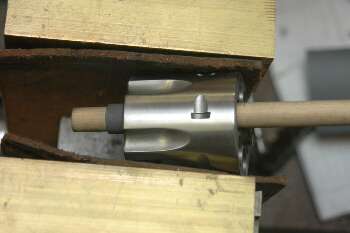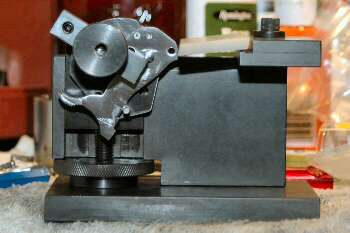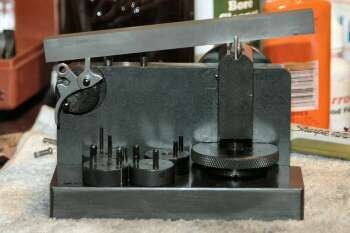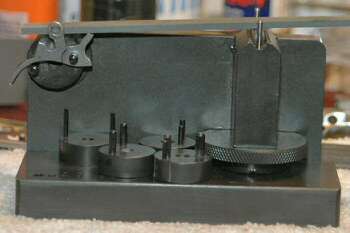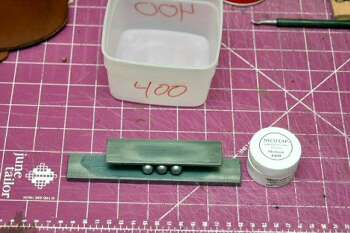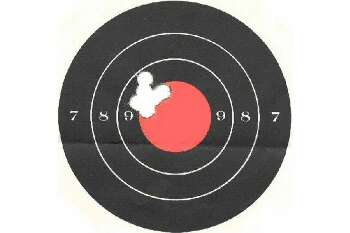Copyright 2006 by Roy Seifert
|
Ruger makes a fine single-action revolver. But like most production firearm manufacturers they canít afford to take the time for custom improvements to turn this revolver into an excellent shooter. Additionally the larger-bore Ruger single action revolvers can have other problems detrimental to accuracy. In this article we will identify those problem areas and improve or eliminate them. I used a stainless steel Ruger Blackhawk with a 7 1/2 inch barrel in .45LC to perform my accurizing tasks. Revolver Accuracy In order to gain maximum accuracy from any revolver, the diameter of the bullets, the cylinder throats, forcing cone, and barrel all must be in harmony. Specifically, the bullet must be one to two thousandths larger than the bore, the bore must be uniform from forcing cone to muzzle, the muzzle must be properly crowned, and the cylinder throats must all be the same diameter as the bullet or .0005" larger. The cylinder throats should not swage the bullets, just guide them. You also need a good trigger pull. I measured these areas on my Blackhawk and this is what I found:
With these measurements this particular revolver would act as follows:
Reaming Cylinder Throats
Action Job NOTE: working on the action requires special tools and jigs and should not be attempted without them. Without these tools surfaces and parts can become rounded to where they will no longer function and/or become dangerous. I purchased Wolf spring kit RSA-106 from Brownells. It contained a reduced power trigger return spring; 17, 18, and 19 lb. hammer springs (factory is 23 lb.); and a stronger base pin plunger spring. First I completely disassembled the gun and polished all trigger parts and pins. I used 320-grit wet-dry sandpaper on a flat surface to polish the sides of the hammer and trigger. I made sure the trigger was not rubbing against the grip frame. After polishing, cleaning and oiling I reassembled the gun using the spring kit with the 19 lb mainspring to test for reliable function. I have two stoning fixtures that are designed specifically for shaping and polishing hammer and sear engagement surfaces, both of which are available from Brownells. The Power Custom Series 1 fixture is used for polishing triggers and sears, and the Power Custom Series 2 fixture is used for polishing the engagement surface on hammers. Available separately for the Series 1 fixture are firearm-specific adapters for working on the trigger or sear of a specific firearm. The Series 2 fixture comes with a universal adapter and multiple sizes of pivot pins to mount different hammers from different firearms for polishing. The universal adapter did not have a pin to fit the Ruger hammer so I used the hammer pivot pin from the gun. With most Ruger SA triggers the trigger sear sits too deeply on the hammer notch. This makes a very safe, but long and creepy trigger pull. Also these surfaces are often just rough ground as they come from the factory so they need some smoothing and polishing. I installed the hammer in my Power Custom Series 2 stoning fixture using the universal adapter. I used the original hammer pivot pin inserted groove first into one of the holes in the adapter. The pin was held in place by a set screw. I made sure the set screw contacted the groove so as not to raise a burr on the pivot surface of the pin. I marked the front edge of the hammer notch with a blue marker and adjusted the fixture until my stone was flat across the front of the notch. The notch in my hammer measured .022" deep so I took a 220 grit stone and carefully reduced the depth of the notch to .014".
The coarse and fine ceramic sticks used above came from Brownells. The narrow stone came from Boride Engineered Abrasives. Fire-Lapping the Barrel Fire-lapping involves imbedding different grits of lapping compound into lead bullets and firing them down the barrel at a very moderate velocity. This process accomplishes a number of positive things:
* Smoothes the barrel making it easier to clean
* Removes tight spots
* Slightly tapers the barrel from forcing cone to muzzle First I took ninety 250 grain bulk-purchased cast lead bullets and laid them in an aluminum pan. I baked them in my toaster oven at 250 degrees for 30 minutes to remove the lubricant from the lube grooves. Then I took the appropriate number of bullets and impregnated them with the proper grit compound.
The plastic bowl in the photo is marked 400 for putting bullets impregnated with 400 grit lapping compound. I also used bowls marked 220, 800 and 1200. Finally, I loaded each round with 4 grains of Red Dot which produced a low velocity load. I started with the 220 grit rounds and fired a cylinder full, then I had to thoroughly clean the barrel and cylinder using a patch soaked with Remington Bore Cleaner and wrapped around a brass bristle brush. Everything got oiled with Hoppes, then I slugged the barrel to gauge the fire-lapping progress. I fired 36 rounds of 220 grit to remove the constriction, cleaning and slugging between every six shots. Then I fired 18 rounds of 400 grit, again cleaning between every six shots, and then 24 rounds of 800 grit for final polish. It is important to clean after every six rounds otherwise you begin to lap the fouling and not the barrel metal. Also, the cases used for fire-lapping should be destroyed. This is because residual compound in the cases can contaminate the bullets and actually cause damage to your newly polished barrel.
This is what is happening now with my accurized revolver:
|
